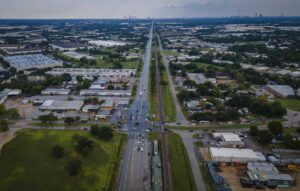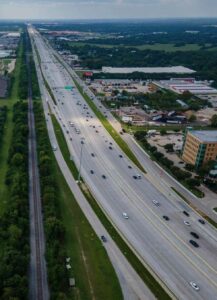West Houston is changing quickly. Following the 290 corridor from Beltway 8 through Waller County, new communities and major employment centers are taking shape in areas that, not long ago, were mostly quiet and rural. Roads that once carried light local traffic now see steady streams of school buses, emergency vehicles, commuters, and freight. Yet much of this network still depends on at-grade rail crossings, where cars and trains meet at the same level. As growth continues, these crossings are becoming pinch points that create congestion, present safety risks, and strain the reliability of an entire corridor that serves hundreds of thousands of people every day.
Investing in grade separations, whether overpasses or underpasses, is one of the most effective ways to make travel safer and more dependable. These projects remove the conflict between rail and roadway traffic, preventing the crashes, delays, and near misses that come with at-grade crossings. For a region that is growing as fast as West Houston, grade separations are not just about improving traffic flow. They are about making sure families, freight, and first responders can move safely and predictably across the region.

Hempstead Road, looking eastbound towards Downtown Houston, runs adjacent to Union Pacific railroad track
The safety argument is the most immediate and most human. At-grade crossings are points of uncertainty, where a single moment of distraction can have tragic results. Even when crashes are avoided, long freight trains create their own hazards. Drivers grow impatient, traffic backs up, and frustrated motorists turn through neighborhoods to find alternate routes. Those diversions ripple through the system, putting both drivers and pedestrians at greater risk. Removing conflict points means removing that danger entirely, and that matters in a corridor where traffic volumes are rising every year.
For families, the impact would be felt in everyday routines. School buses that carry dozens of children through this area must navigate rail crossings under tight schedules, often waiting for trains or dealing with congestion caused by them. A grade separation means those buses can cross safely and on time, easing pressure on drivers and offering parents greater peace of mind. Emergency responders would see similar benefits. Fire trucks and ambulances cannot wait at a train crossing or in a long queue of cars. Every second counts when responding to a call, and reliable access could quite literally save lives. Elevating parts of the roadway network also helps during major rain events, providing a more dependable route when water covers low-lying areas.
The economic argument is equally strong. Along the 290 corridor, tens of thousands of new homes are planned or under construction. Master-planned communities west of the Grand Parkway are rising alongside one of the largest manufacturing centers in the country, the Daikin Texas Technology Park. Each new neighborhood and job site adds more daily trips and more pressure on the same crossings that are already strained. Without improvements, the problems we see today will multiply as the population grows, slowing freight, frustrating commuters, and limiting access for businesses that depend on timely deliveries and workers who rely on consistent travel times.

290 Corridor, looking westbound towards Waller, runs adjacent to Union Pacific railroad track
Planning ahead is the key. Once land is fully developed, options for realignment or construction become limited and expensive. Identifying and preserving locations for future grade separations today will make it possible to build smarter and more affordably tomorrow. The longer the region waits, the harder and costlier it becomes to create solutions that truly fit.
Funding can come together through a combination of local and regional tools. Federal programs like Surface Transportation Block Grants and Congestion Mitigation and Air Quality funds are well suited for rail-highway conflict removal. TxDOT’s safety initiatives provide another avenue for support. The Federal Railroad Administration has several grant programs available to participate in costs. Most recently, in the 89th Legislative Session, created a state-funded road/rail grade crossing elimination program. Locally, counties and cities can establish Tax Increment Reinvestment Zones that capture the rising property tax values generated by new development and reinvest those funds into mobility improvements. Combined with county mobility bonds and developer participation agreements, this layered approach ensures that costs are shared fairly among those who benefit most.
When these projects are built, they should reflect the kind of quality growth that West Houston stands for. Bridges and underpasses can be designed with thoughtful lighting, landscaping, and community branding that make them assets rather than eyesores. Good drainage and stormwater features can improve both safety and sustainability, turning what might otherwise be an engineering project into a community investment.
The 290 corridor represents one of the most dynamic areas of growth in the Greater Houston region. With that growth comes both opportunity and responsibility. Grade separations along this stretch are about more than convenience or commute times. They are about protecting lives, supporting economic vitality, and building a network that can handle the next generation of growth. The choice is whether to plan ahead now, while the options are still flexible, or wait until congestion, safety issues, and costs grow beyond our control. Quality growth depends on foresight, and the time to act is now.

This piece was written by Jim Webb, CEO at The Goodman Corporation
and Chair of WHA’s Regional Mobility Committee
